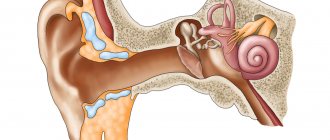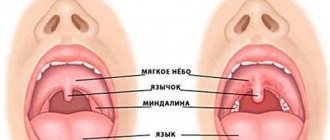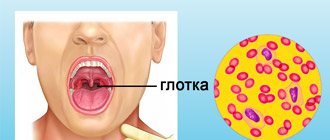Hypertrophic (granular) pharyngitis, what is it and how does it develop?
Sore throat with hypertrophic pharyngitis
Hypertrophic pharyngitis occurs as a complication of acute inflammation in the throat. If you do not start timely treatment of catarrhal pharyngitis, or do not support the functioning of the immune system, then mild inflammation begins to affect deeper tissues and involve blood vessels and lymphatic ducts in the process.
Hypertrophy begins due to pathological changes in the connective tissue of the mucous membrane, enlargement of capillaries and glands, expansion and fusion of lymphoid formations. With a long course of hypertrophic pharyngitis, inflammation covers the muscle tissue.
The disease is often accompanied by the formation of granules on the back wall of the larynx, which are small nodules containing accumulations of dead tissue, dead leukocytes and fibrin fibers. As chronic hypertrophic pharyngitis progresses, the granules grow, merge with each other and become covered with a crust of thick mucus.
Unlike acute inflammation of the throat, hypertrophic pharyngitis is characterized by a protracted course, poor responsiveness to drug treatment and frequent relapses. It is impossible to completely restore the affected tissues, but with properly selected therapy, chronic hypertrophy can be stopped.
Symptoms
Symptoms of chronic pharyngitis include:
- Unpleasant sensations in the throat (soreness, burning, dryness).
- Sore throat, worsening in the morning when swallowing.
- The formation of mucus, which irritates the pharyngeal mucosa and provokes a cough.
- Dry cough in the morning and at night.
- Redness and swelling of the throat.
- Fever, general weakness, aches in muscles and joints (rare).
Each type of pharyngitis is characterized by its own specific symptoms.
Catarrhal chronic pharyngitis is accompanied by redness of the throat, swelling of the pharyngeal mucosa, and hypersecretion of mucus. The back wall of the pharynx may be covered with clear or cloudy mucus.
With hypertrophic rhinitis, detachment of the pharyngeal epithelium occurs, and growths and depressions form in its place. The palate and uvula are enlarged, and there is a lot of mucus on the back of the pharynx.
Hypertrophic chronic pharyngitis can be granulosa and lateral. In the first case, the lymphoid tissue of the posterior pharyngeal wall becomes covered with red granules. And in the second case, it grows, and the palatine and lingual tonsils become inflamed.
Chronic atrophic rhinitis is accompanied by thinning of the pharyngeal mucosa, which becomes dry and yellow (or pale pink) with purulent secretion on the surface, as well as blockage of the mucous glands.
Causes of hypertrophic pharyngitis
Chronic hypertrophic pharyngitis occurs in children and adults as a consequence of severe and untreated respiratory tract diseases. The most common causes of inflammation are the following diseases:
- Sinusitis.
- Frontit.
- Sinusitis.
- Adenoiditis.
- Hay fever.
- Persistent rhinitis.
- Tonsillitis.
- Angina.
- Bronchitis.
- Tracheitis.
The main causative agents of hypertrophic pharyngitis can be identified: herpes viruses, influenza viruses, rhinoviruses, Candida fungi, streptococcal and staphylococcal bacteria. It is under their influence that inflammation begins, leading to the growth of throat tissue.
Chronic hypertrophic pharyngitis is provoked by a variety of causes, local and systemic:
- surgical interventions in the nasopharynx;
- inhalation of polluted air, chemical fumes;
- hypothermia of the body;
- presence of bad habits;
- hormonal disorders;
- abnormal structure of the nasopharynx;
- decreased immunity, immunodeficiency diseases;
- severe stress;
- physical fatigue.
Swelling of the mucous membrane can occur against the background of other congestive diseases, for example, metabolic disorders or certain cardiac and renal pathologies.
Classification
Inflammation of the pharyngeal mucosa manifests itself most strongly in places where lymph nodes and blood vessels are concentrated; the following are distinguished:
- catarrhal pharyngitis;
- hypertrophic;
- atrophic.
With catarrhal pharyngitis, there is a persistent dilation of small blood vessels and swelling of the mucous membrane.
With hypertrophic pharyngitis, the epithelial membrane thickens, becomes denser, and the capillaries dilate. Granules of lymphoid tissue become red and scatter over the surface of the mucosa. The blood vessels are filled with blood, the mucous membrane is swollen, reddened, and there is increased secretion of the glands.
When the process is localized on the back wall of the pharynx, they speak of granulosa pharyngitis; when the lateral walls of the pharynx are affected, they speak of lateral hypertrophic pharyngitis.
With atrophic pharyngitis, the secretion of the mucous glands is reduced, the mucous itself is thinned and dehydrated. In the initial stages of mucosal atrophy, decreased secretion, and increased viscosity of secretions, the disease is characterized as subatrophic pharyngitis.
With severe atrophy, desquamation of the cells of the epithelial lining of the pharynx and dryness of the mucous membrane are observed. Crusts accumulate on it, irritating the nerve endings that cause a cough reflex.
In attempts to cough up crusts, the patient loses sleep and strains his vocal folds. A painful dry cough with pharyngitis may be accompanied by the release of dense crusts.
Forms of the disease
Hypertrophic pharyngitis
Hypertrophic pharyngitis occurs as chronic inflammation. It is divided into two forms, depending on the location of the pathological process. The first form and the most common is chronic hypertrophic pharyngitis, characterized by a severe inflammatory process at the back of the throat and the formation of granules.
Less common is lateral hypertrophic pharyngitis, which affects the lateral ridges. They become covered with fibrous tissue, swell and appear loose and lumpy.
In the rarest cases, lateral and hypertrophic pharyngitis are combined. But this occurs only with prolonged and severe inflammation. In adolescence, in isolated cases, a combination of hypertrophy and atrophy occurs, which can complicate diagnosis.
Symptoms of hypertrophic pharyngitis
The manifestations of hypertrophic pharyngitis are extremely complex and cause many unpleasant moments for the patient, forcing them to seek help from a specialist
Clinical signs of hypertrophic forms of pharyngitis include:
- prolonged intense sore throat;
- severe discomfort at rest and when swallowing;
- constant feeling of a “lump” in the throat and the need to swallow frequently;
- viscous mucus running down the back of the throat;
- nausea, urge to vomit;
- frequent dry irritating cough;
- bad breath and aftertaste;
- tickling, itching and constant dryness in the throat;
- enlargement of the submandibular and anterior cervical lymph nodes.
The severity of the symptoms of the disease depends on the degree of damage to the pharynx and the severity of the inflammatory process. With lateral pharyngitis, due to a significant increase in the lateral ridges, the pharynx visually looks narrow, and the back wall is hyperemic and swollen.
During pharyngoscopy with granulosa pharyngitis, bright red formations on the back wall of the pharynx are clearly visible, interspersed with purulent streaks
Symptoms of hypertrophic pharyngitis in children and adults
The symptoms of hypertrophic pharyngitis are so pronounced that they allow the doctor to make the correct diagnosis based on complaints. But sometimes the symptoms are blurred if hypertrophic pharyngitis is accompanied by other diseases.
What does the patient complain about:
- severe pain, worsening in the morning due to dry crusts in the throat, as well as when swallowing saliva and food;
- tickling, dry cough, but after clearing the throat there is no relief;
- constant sensation of a foreign body in the larynx, due to overgrown tissue and accumulation of thick mucus;
- increased dryness and constant thirst;
- change in voice timbre, slight hoarseness;
- increase in body temperature to 37-38°C.
Attention! With hypertrophic pharyngitis, attacks of suffocation may develop.
The symptoms of hypertrophic pharyngitis are especially pronounced in children. They experience more severe pain, and often become completely hoarse due to significant proliferation of mucous epithelium. Young children become whiny, are constantly capricious, drink a lot, and then refuse to eat.
Adults and children experience increased weakness, headaches, dizziness and bouts of nausea. These signs lead to nervousness and irritability, interfere with sleep and reduce performance.
Chronic hypertrophic pharyngitis: symptoms, treatment and prevention
Diseases of the upper respiratory tract vary in their associated symptoms and the severity of the treatment process.
The most long-lasting, sluggish inflammation of the larynx is chronic hypertrophic pharyngitis.
The mucous membrane of the pharynx, with the help of tonsils and lymph nodes, actively protects the body from the penetration of infections and bacteria. Therefore, she needs high-quality and timely treatment.
Catarrhal pharyngitis is shallow changes in the mucous membrane with a clear sign of redness and slight swelling.
Pharyngoscopic picture
Pharyngitis, which occurs in a hypertrophic form, cannot always be distinguished from inflammation of the pharynx of another type, based only on the patient’s complaints. Manifestations of the inflammatory process, especially during an exacerbation, are similar - fever, weakness, sore throat. To carry out differential diagnosis, a visual examination of the pharyngeal mucosa is required. With hypertrophic inflammation, you can identify:
- redness, thickening and hardening of the mucous membrane;
- swelling of the pharyngeal mucosa;
- the presence of red, “granular” follicles of round or oblong shape;
- the presence of branching veins, copious amounts of mucus;
- swelling of the uvula and soft palate.
Since mucus production is increased, when coughing, an admixture of mucous secretions appears in the saliva. Redness and swelling are noticeable even without an exacerbation, enlarged lymphadenoid follicles rise above the surface of the mucous membrane.
These products are used not only for rinsing, but also for irrigation with a spray bottle and inhalation.
Causes
In eight cases out of ten, pharyngitis occurs due to various viruses entering the pharynx, for example, influenza viruses, parainfluenza, adenoviruses, and so on.
With regular recurrences of the disease, local immunity decreases, and the body is no longer able to fight pathogenic microorganisms. Sometimes it is enough just to be slightly hypothermic or drink cold water for pharyngitis to worsen. This is how the disease gradually becomes chronic.
Factors that contribute to the development of chronic pharyngitis include:
- Drinking alcohol, smoking.
- Constant inhalation of dirty and dusty air.
- A profession that involves working in hazardous conditions.
- Abuse of cold or hot water and food with a lot of seasonings.
- Weakening of the body's immune forces.
- The presence of other infectious diseases of the nasopharynx, for example, polyps, sinusitis or chronic rhinitis.
In some cases, chronic pharyngitis is an independent disease. The causes of its occurrence may be problems with the stomach and intestines.
Most often, adults are diagnosed with chronic catarrhal pharyngitis. Its transition to an atrophic or hypertrophic form can be triggered by diabetes, diseases of the thyroid gland, heart, kidneys, liver, as well as factors such as dry and polluted air, tobacco smoke.
In some cases, chronic pharyngitis is an independent disease.
Signs of the disease
You can recognize the hypertrophic type of pharyngitis by the following signs:
- Purulent mucous discharge of a viscous and thick consistency;
- Frequent expectoration, accompanied by nausea and vomiting;
- Drying mucus forms crusts on the surface of the throat;
- Upon visual examination, bright red formations interspersed with purulent streaks are clearly visible. Most often they spread to the back of the throat;
- On the lateral ridges, which are noticeably enlarged, tuberous growths are observed.
Diagnosis of the disease
Diagnosis of hypertrophic pharyngitis begins with interviewing the patient. The doctor finds out what caused the pathology, what diseases could provoke inflammation in the throat, and what symptoms torment the patient.
Pharyngoscopy
After collecting anamnesis, an examination of the pharynx is performed. Pharyngoscopy allows you to determine the form of the disease and the localization of the inflammatory process. During the examination, the doctor removes a small amount of mucus from the throat to send it for analysis to identify the pathogen.
To determine the general condition of the body, the following is carried out:
- General blood analysis.
- General urine analysis.
- Immunogram.
Diagnosis may require PCR testing if the throat swab is inconclusive. Using PCR, you can identify even a small number of pathogens and their type.
If the ENT specialist is unable to identify the cause of hypertrophic pharyngitis, the patient is referred for consultation to other specialists, a dentist, rheumatologist, or endocrinologist. These specialists may refer the patient for additional tests and examinations.
What kind of disease is this and what are the causes?
hypertrophic pharyngitis in the photo
Hypertrophic pharyngitis is a chronic inflammation of the anterior wall of the throat, as well as the lower segments of this part of the patient’s body. As a result of this pathological process, the mucous membrane, epithelial tissue, as well as lymph nodes, begin to degrade and increase to critical sizes.
The most dangerous thing is that the process is irreversible and after the tissue grows, there is a gradual loss of functionality of the affected areas of the throat. Over time, benign formations consisting of cells of its own epithelium begin to form on the walls of the larynx.
Based on established medical practice, the following forms of hypertrophic pharyngitis are distinguished.
granular
Hypertrophy of the throat surface appears exclusively on the posterior wall and is limited only to this area of the pharynx. Accordingly, granules and nodular formations are also concentrated only in this area.
Lateral pharyngitis
In the affected area are the lateral walls of the throat and they are covered with fibrous tissue, which has a heterogeneous appearance, is distinguished by tuberosity, elevations and its general appearance is very painful.
The longer the presence of the inflammatory process in the larynx, the more pronounced the signs of hypertrophy of the mucous membrane of the throat become with a violation of the integrity of the epithelial coating. The reason for the occurrence of the disease is always the same, and it lies in the fact that the person had not previously treated a sore throat, the disease became chronic and led to such negative consequences. Indirect factors causing hypertrophy also include:
- smoking;
- alcoholism,
- allergic reactions;
- harmful working conditions with inhalation of acid fumes;
- diseases of the digestive system, when gastric juice regularly enters the larynx;
- disruption of metabolic processes in the body;
- hereditary tendency to the occurrence of this kind of disease;
- chronic rhinitis, sinusitis or sinusitis.
If at least one of the listed reasons is present in a person’s life, then the probability of getting this disease is within 70% and the risk of developing a hypertrophic form of pharyngitis remains very high.
Possible complications and consequences
The most common complication of chronic hypertrophic pharyngitis is the replacement of mucosal cells with connective tissue and the transition to an atrophic form. If atrophic pharyngitis develops, it will be much more difficult to treat, in addition, it can cause malignant neoplasms in the throat.
Other complications of hypertrophic pharyngitis:
- Retropharyngeal abscess.
- Breathing problems, asthma attacks.
- Lymphadenitis.
- Frequent respiratory diseases.
Pathological inflammation can spread to surrounding tissues and provoke the development of laryngitis, tonsillopharyngitis, tracheitis and other ENT diseases. If the process rises into the nasopharynx, then the risk of adenoid proliferation increases. This complication occurs especially often in young children.
Pharyngitis in children
Children are especially susceptible to adenovirus infection between the ages of 6 months and 3 years. A typical manifestation of inflammation of the pharynx caused by an adenovirus is considered to be pharyngoconjunctival fever .
This disease is observed in children's institutions in the form of sudden outbreaks, it is highly contagious, has a short incubation period (5-6 days), is characterized by acute symptoms, proceeds violently, with a sharp deterioration in health.
The patient's temperature rises sharply, there is profuse nasal discharge, a dry cough, which is later replaced by a wet cough with sputum. Usually, from the very beginning of the disease, symptoms of conjunctivitis are observed - light, thin films appear on the conjunctiva, first on one eye, then spreading to the second eye.
Frequent bowel movements and vomiting are also noted. Complications of the disease can include sinusitis (sinusitis, frontal sinusitis), bronchitis, adenoviral pneumonia, characterized by intoxication of the body, severe course, infectious damage to the heart muscle - myocarditis.
Another type of adenoviral infection that often affects young children is erythematous pharyngitis . The disease is transmitted both by airborne droplets and fecal-oral routes. Outbreaks of the disease occur when children are overcrowded and have poor ventilation.
The variety of symptoms of erythematous pharyngitis is due to the ability of the adenovirus to multiply in the tissues of the respiratory tract, eyes, and intestines. 5 days after infection, the patient suddenly begins to feel chills, the temperature rises, aches and discomfort appear in the bones and muscles.
Itching, soreness, and pain appear in the throat when swallowing saliva. A characteristic symptom of adenovirus infection is a severe runny nose from the very first days of illness.
The pharyngeal mucosa is swollen, covered with purulent plaque, and bright red granules of lymphoid tissue are noted on the back wall. The submandibular lymph nodes are inflamed. The cervical lymph nodes are also involved in the inflammatory process.
The adenovirus also affects the eyes, which is manifested by pain in the eyes, lacrimation, and redness of the conjunctiva. The addition of a bacterial infection can lead to sore throat, sinusitis, and pneumonia.
A bacterial infection can independently cause inflammation of the pharyngeal mucosa. With bacterial pharyngitis, changes affect mainly the lymphoid tissue on the back wall of the pharynx - the granules become inflamed, become clearly visible, bright red.
In children, acute pharyngitis often occurs as a secondary disease with sinusitis, inflammation of the adenoids. Purulent discharge from the nose, flowing down the back wall of the nasopharynx, enters the laryngopharynx.
Here, irritating the mucous membrane, the secretions cause a cough reflex. The child tries to get rid of phlegm, coughs forcefully, “squeezing”, weakening the vocal folds, which leads to hoarseness.
Forecast
It is quite difficult to predict the outcome of hypertrophic pharyngitis. The prognosis depends on the timeliness and quality of treatment. If therapy was started on time and the patient followed all the recommendations of the attending physician, then the disease can be completely eliminated.
But, if the pharynx is constantly affected by negative factors, then granulosa pharyngitis may drag on, and the treatment will not bring results. With a protracted course of the disease, it will be almost impossible to bring the laryngeal tissues to a normal state.
Causes
Hypertrophy of pharyngeal tissue occurs against the background of frequent inflammation of the respiratory tract. Tonsillitis, chronic sinusitis and adenoiditis, acute pharyngitis are interrelated diseases that weaken the local immunity of the pharynx. Destructive environmental factors play an important role in the chronicity of pharyngitis:
- Smoking;
- harmful production conditions (dusty, hot air or sudden temperature fluctuations, vapors of oxidizing or toxic substances).
Predisposing factors to the development of hypertrophic pharyngitis are:
- Hereditary characteristics of the pharyngeal mucosa and its lymphadenoid structure;
- swelling of the pharyngeal mucosa as a result of congestion in the nasopharynx, occurring against the background of other systemic diseases of the body (in particular, the heart and blood vessels);
- metabolic diseases.
Simple (catarrhal) pharyngitis
With catarrhal pharyngitis
the patient complains of
sore throat, sore throat when swallowing
, a feeling of a “lump” in the throat and a dry cough. The mucous membrane of the pharynx is red with mucopurulent discharge.
When suffering from catarrhal pharyngitis, frequent gargling with alkaline solutions and lubrication of the mucous membranes with Lugol's solution or protargol are recommended.
To achieve a lasting and rapid effect, it is necessary to combine the use of local drug treatment with laser therapy.
The use of a course of light therapy with a therapeutic laser allows you to restore the protective and antibacterial functions of the oropharyngeal mucosa. For frequent exacerbations of pharyngitis, the use of 3-5 sessions of photodynamic therapy is indicated.
Catarrhal form is the most common
Treatment
General recommendations
During exacerbations of pharyngitis, bed rest is advisable for a person.
At the time of exacerbation, the body is susceptible to infection by all kinds of infections and activation of its own pathogenic microflora, therefore it is extremely important during this period:
- Maintain hygiene;
- Avoid fatty, rough foods;
- vitaminize food;
- Drink more clean water;
- Get a good night's sleep;
- Avoid stressful situations;
- Stop smoking.
Often adult patients suffer exacerbations of this disease “on their feet”, not realizing that this only worsens the effectiveness of therapy.
Medication
- Conservative therapy for hypertrophic pharyngitis requires antibiotics (macrolides, penicillin drugs or cephalosporins). Conservative therapy also involves the following actions:
- Use of antiseptics (Hexoral, Strepsils).
- The use of topical anti-inflammatory drugs (Tantum Verde spray, Ingalipt).
- To improve metabolic processes, vitamins are prescribed, as well as immunostimulants (Likopid, Ribomunil).
- Treat the affected tissue with Lugol, Protargol.
- To destroy the granules, they are cauterized with trichloroacetic acid.
- Medicines such as Proposol and Resorcinol are used to disinfect the throat and relieve inflammation.
Folk remedies
- Gargling with oak bark infusion and soda solution.
- To remove crusts and thin mucus, it is effective to irrigate the larynx with sea water.
- Inhalations with herbal infusions with sage and lavender.
- Inhalations with mineral water and alkali.
- Oil inhalations with the addition of lavender, fir, menthol or sea buckthorn oils to hot water.
- Propolis extract with peach oil is effective for lubricating the throat.
- Medicinal expectorants are added to milk with honey (helps with dry cough).
- A collection of yarrow and chamomile (for rinsing).
- Inhalations with pine buds.
- Unrefined vegetable oil is mixed with salt (to lubricate the throat).
How to treat pharyngitis at home, watch our video:
Physiotherapy
- Medicinal electrophoresis.
- Inductometry.
- Irradiation of granules with ultraviolet light.
- Thalassotherapy.
Surgical methods
For advanced complex forms of pharyngitis, laser surgery methods are used.
Indications:
- Severe proliferation of fibrous tissue.
- Critical amount of compactions and granules.
- Ineffectiveness of conservative therapy.
- Swelling of the larynx, which can cause suffocation.
Clinical picture
Like any chronic disease, hypertrophic pharyngitis is not characterized by varied symptoms. The main and often only complaint of patients is a sore throat. Pain with hypertrophic pharyngitis has the following characteristic features:
- Intensive;
- long-term;
- does not decrease from self-treatment.
Typical symptoms accompanying pain:
- Unpleasant sensations when swallowing;
- need to swallow frequently;
- tickling in the throat, soreness;
- a feeling of “something is bothering you” in the throat.
Examination of the throat reveals:
- Swelling of the mucous membrane;
- redness;
- increase in lymphoid granules;
- increase in lateral lymphoid ridges;
- mucopurulent discharge, which, when dried, acquires a dark color and viscous structure.
Depending on the degree of chronicity and intensity of the processes occurring in the pharynx, a fairly common, but not obligatory, symptom of hypertrophic pharyngitis is coughing. Otherwise, the person remains functional and does not feel sick or weak; the temperature is not elevated.
Carrying out diagnostics
Lateral pharyngitis can very often be combined with other pathologies of the ENT organs, so a comprehensive diagnosis is required. It means:
- determination of the external condition of the pharyngeal mucosa, as well as examination of the neck; palpation of the larynx; general blood test; throat smear to determine the causative agent of the virus; laryngoscopy.
This disease occurs equally in children and adults, so when the first signs appear, you should visit a doctor. If comprehensive treatment is not carried out in a timely manner, complications may occur. The most severe consequence of the disease is tissue swelling, during which it becomes very difficult for a person to breathe and signs of respiratory failure appear.











